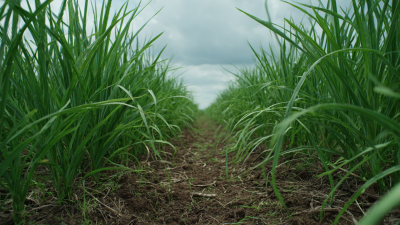 0551-68500918
0551-68500918 





In today’s ever-changing world of pest control, using Carbaryl Liquid has really become a go-to for gardeners wanting to keep their plants safe. The Global BioPesticides Market report points out that there's been a huge rise in interest for innovative solutions—biopesticides, in particular, are expected to grow at about 15.1% annually from 2021 to 2028.  Carbaryl, which is a type of carbamate insecticide, is popular because it can handle a bunch of different pests and is pretty easy for DIY gardeners to use. Innovation Meiland (Hefei) Co., LTD., dedicated to creating advanced pesticide products, crafts the Carbaryl Liquidright in its headquarters in Hefei, China, using the latest research. If gardeners know how to get the most out of Carbaryl Liquid, they can enjoy healthier plants and better pest control—plus, they’re also helping grow the bioPesticide Industry in the process. It’s all about making pest management more effective and accessible, after all!
Carbaryl, which is a type of carbamate insecticide, is popular because it can handle a bunch of different pests and is pretty easy for DIY gardeners to use. Innovation Meiland (Hefei) Co., LTD., dedicated to creating advanced pesticide products, crafts the Carbaryl Liquidright in its headquarters in Hefei, China, using the latest research. If gardeners know how to get the most out of Carbaryl Liquid, they can enjoy healthier plants and better pest control—plus, they’re also helping grow the bioPesticide Industry in the process. It’s all about making pest management more effective and accessible, after all!
So, carbaryl is this pretty popular insecticide that's really good at taking care of various pests that can threaten your garden plants. It's mainly made up of 1-naphthyl N-methylcarbamate, and what it does is pretty interesting — it blocks an enzyme called acetylcholinesterase, which bugs need for their nervous system to work properly. When this enzyme's shut down, neurotransmitters start piling up, and honestly, it pretty much knocks the pests out or even kills them. Knowing how it works can help you use it wisely and effectively in your pest control routine.
When you're using carbaryl, it’s super important to stick to the recommended guidelines to avoid harming beneficial insects or messing up the environment. A good tip is to apply it either early in the morning or late in the evening, when friendly bugs are less active. Also, don’t forget to wear protective gear — gloves and masks are a must — to keep your skin safe and avoid inhaling fumes accidentally. Oh, and it’s a smart move to switch up your pest control methods instead of relying on carbaryl all the time. That way, you can prevent pests from developing resistance, keeping your garden healthy and pest-free in the long run.
 When you're using Carbaryl liquid to control pests in your garden, getting the dilution right is super important if you want it to work effectively. According to the EPA, Carbaryl is a pretty common insecticide that targets over 100 different pests, like aphids and beetles. Usually, you'll want to mix about half an ounce to two ounces of the concentrate per gallon of water, but that can vary depending on how bad the infestation is. The goal is to keep the active ingredient strong enough to do its job, but not so concentrated that it harms helpful insects or your plants.
When you're using Carbaryl liquid to control pests in your garden, getting the dilution right is super important if you want it to work effectively. According to the EPA, Carbaryl is a pretty common insecticide that targets over 100 different pests, like aphids and beetles. Usually, you'll want to mix about half an ounce to two ounces of the concentrate per gallon of water, but that can vary depending on how bad the infestation is. The goal is to keep the active ingredient strong enough to do its job, but not so concentrated that it harms helpful insects or your plants.
Also, timing and the way you apply it really make a difference. Studies in the Journal of Economic Entomology suggest that spraying in the early morning or late evening tends to work better because pests are more active during those times. Plus, using a sprayer that creates a fine mist helps get good coverage, especially on the undersides of leaves where pests like to hide. If you follow these tips—sweet spot in dilution, right timing, and proper spraying—you'll be able to keep those pests in check while still keeping your garden healthy and happy.
When you're using Carbaryl liquid to keep pests at bay in your garden, it’s really important to first figure out what kind of pests you're dealing with. Stuff like aphids, spider mites, and whiteflies—those tiny nuisances—can cause lots of headaches, especially in vegetable patches. I recently came across a review about pesticide residues in Bangladesh, and it actually pointed out that these pests are major culprits behind crop losses, seriously squeezing vegetable yields. So, knowing exactly what pests are attacking your plants can make all the difference. Misidentifying or overreacting might mean you end up using more chemicals than necessary—plus, there's the health side of things, since overusing pesticides isn't exactly great for us or the environment.
Now, Carbaryl works pretty well against a wide range of these pests because it messes with their nervous systems. That said, there’s been quite a bit of recent research reminding us to use such chemicals wisely. Blending sustainable practices with smarter pest management, like catching pests early and using natural methods when possible, can cut down health risks and help your garden thrive. Tools like pest identification guides or trusted reports about pesticide impacts can really help you decide when and how to bring Carbaryl into play—aiming for that sweet spot where you keep pests away without harming the ecosystem or yourself.
When you're using Carbaryl liquid to handle pests in your garden, it’s super important to prioritize safety — not just for yourself, but also for the helpful bugs that keep your garden healthy. Before you start spraying, make sure you’re wearing gear like gloves, a mask, and goggles. Trust me, it’s worth the effort to avoid skin contact or breathing in fumes. Oh, and getting the right amount of product is a big deal — putting on too much can be risky health-wise and might leave residues that aren’t great for the soil or nearby water sources.
Timing is everything when it comes to protecting good insects. Try to apply Carbaryl either early in the morning or late in the evening when bees and other pollinators aren’t as active. If you can, go for targeted methods like spot spraying to limit the impact on beneficial insects. And definitely follow the instructions on the label — it’s there for a reason. Never spray during flowering times, because you don’t want to accidentally harm those vital pollinators. By keeping these safety tips in mind, you can keep those pesky pests at bay while still giving your garden a fighting chance to flourish.

If you're looking to get the best results when tackling pests in your garden with Carbaryl liquid, timing and how often you apply it really matter. Honestly, the best bet is to start using it early on, right when you first notice pests showing up. Catching them early means you can stop them before they do too much damage to your plants. And a little tip — applying in the early morning or late afternoon works better, since the cooler temperatures help reduce evaporation and make the pesticide more effective.
To keep pests at bay for good, set up a regular plan. Depending on how bad the infestation is and the weather, you might want to reapply every week or two — so about 7 to 14 days apart. Make sure you keep an eye on your garden between treatments, just in case pests are still hanging around. If they’re still a problem, you might have to do it more often. Also, don’t forget to follow the manufacturer’s instructions on safe dosages and any restrictions for particular plants or crops. That way, you stay safe and get the best results without any mishaps.
Using Carbaryl for pest control has definitely raised some serious environmental eyebrows. People are concerned about how it affects soil health and the bugs and creatures that live there. You see, Carbaryl is a type of insecticide called a carbamate, and studies have shown it can mess with the tiny microbes in the soil—that's a big deal because these microbes are super important for keeping the soil fertile and the ecosystem in balance. For example, a report from the EPA back in 2021 pointed out that high levels of Carbaryl can wipe out some of these essential microbes, which then messes up how nutrients get cycled and how organic stuff breaks down in the ground.
And it doesn’t stop there. The impacts on biodiversity can be pretty serious too. Research suggests that Carbaryl can hurt non-target creatures like helpful insects, including pollinators like bees—and even predator insects that help control pest populations naturally. There was a study published in Ecotoxicology showing that ladybug numbers drop significantly after exposure to Carbaryl, and since ladybugs are major allies in natural pest control, that’s kind of a big deal. Plus, considering that around 70% of plant species rely on insects for pollination, the unintended fallout from using this chemical could ripple out into ecosystems and farms everywhere. It’s a reminder that messing with one part of the chain can threaten both the environment and our food supply.
| Parameter | Impact on Soil Health | Impact on Biodiversity | Recommended Usage |
|---|---|---|---|
| pH Level | Can lower soil pH | May harm beneficial organisms | Apply sparingly, test soil pH |
| Microbial Activity | Potentially reduced | Negative impact on soil fauna | Use as a targeted treatment |
| Persistence | Can remain in soil for months | Long-term effects on ecosystem | Rotate with other pest control methods |
| Water Solubility | Highly soluble | Risk of runoff into water systems | Avoid application before heavy rain |
: Carbaryl is particularly effective against common garden pests such as aphids, spider mites, and whiteflies, which are notorious for threatening vegetable gardens.
Effective pest identification is crucial as mismanagement may lead to unnecessary pesticide use and potential health risks associated with contamination.
Gardeners should wear protective gear such as gloves, masks, and goggles to minimize skin contact and inhalation of fumes. Additionally, understanding the proper dosage is essential to avoid over-application.
It is advisable to apply Carbaryl during early morning or late evening when beneficial insects like bees are less active, minimizing the risk of harming them.
Studies indicate that Carbaryl can alter the composition of soil microbial communities, which are essential for maintaining soil fertility and ecosystem balance, potentially reducing nutrient cycling and organic matter decomposition.
Carbaryl may have detrimental effects on non-target organisms, including beneficial insects like pollinators, resulting in declines in populations such as ladybugs, which are important for natural pest management.
Over-application increases health risks and can lead to harmful residues that affect soil life and water sources.
Gardeners can minimize health risks by adhering to product instructions, employing targeted application methods like spot spraying, and avoiding spraying during blooming periods to protect pollinators.
The use of Carbaryl raises concerns regarding its impact on soil health, biodiversity, and its potential to disrupt essential ecological functions.
Combining sustainable gardening practices with integrated pest management strategies can help minimize health risks while ensuring effective pest control and ecological health.
Carbaryl Liquid is pretty effective when it comes to dealing with common pests in your garden. Knowing what's in it and how it works can really help you use it safely and get the best results. It's super important to follow the right mixing instructions so you can control pests without risking safety — for you or the helpful bugs in your yard.
Figure out exactly which pests you're targeting first—that way, you're not wasting product or harming things you want to keep around. Also, timing and how often you apply it play a big role; you want to keep pests away without messing up your soil health or losing beneficial insects. Our team at Innovation Meiland (Hefei) Co., LTD. truly cares about responsible pesticide use, because we believe in helping you garden sustainably while keeping everything balanced and safe.
Using Carbaryl Liquid wisely isn’t just about pest control — it’s about staying mindful of the bigger picture. So, a little know-how and some common sense can go a long way here!







